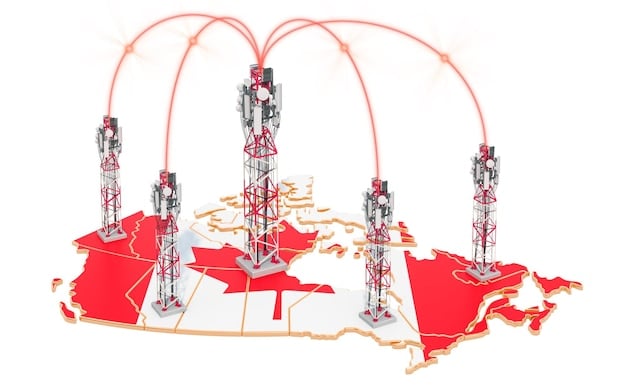5G in the US: Spectrum Auction Results and Future Impact

The future of 5G in the US: What the Latest Spectrum Auction Results Mean for Consumers and Businesses is poised for significant advancements, influencing both consumer experiences and business operations through enhanced connectivity and innovative applications.
As the landscape of wireless technology rapidly evolves, understanding the implications of spectrum auctions is crucial. Delve into the future of 5G in the US: What the Latest Spectrum Auction Results Mean for Consumers and Businesses, and how these outcomes will shape our digital world.
Understanding the Significance of 5G Spectrum Auctions
5G spectrum auctions are pivotal events that determine which companies gain access to the radio frequencies necessary for deploying 5G networks. These auctions dictate the speed, capacity, and coverage of 5G services available to consumers and businesses across the United States.
Acquiring spectrum licenses is a critical investment for telecom companies, as it enables them to expand their network infrastructure and offer faster, more reliable services. The outcomes of these auctions often have long-lasting effects on the competitive landscape of the telecommunications industry.
What is Spectrum and Why is it Important?
Spectrum refers to the range of radio frequencies used for wireless communication. It’s a finite resource, and access to it is carefully regulated by government agencies like the Federal Communications Commission (FCC) in the US. Different frequencies offer different benefits, such as broader coverage or higher bandwidth.
How Spectrum Auctions Work
Spectrum auctions are competitive bidding processes where telecom companies vie for licenses to use specific radio frequencies. The FCC sets the rules and procedures for these auctions, which can last for weeks or even months. Successful bidders gain the right to deploy 5G services using the licensed spectrum in designated geographic areas.
- Bidding Process: Companies submit bids for the spectrum licenses they desire.
- Auction Rules: The FCC establishes rules to ensure fair competition and efficient spectrum allocation.
- License Acquisition: Winning bidders obtain licenses to use the spectrum for a specified period.
Ultimately, the results of these auctions influence how quickly and effectively 5G technology can be rolled out across the US, impacting everything from mobile broadband to IoT devices.
Key Players in the Latest US 5G Spectrum Auction
The latest 5G spectrum auction in the US saw fierce competition among major telecom players. Understanding who the key participants were and how much spectrum they acquired provides valuable insights into their strategic priorities and future network deployment plans.
Several major carriers actively participated in the auction, each with their own specific needs and objectives. Their investments in spectrum acquisition will directly influence their ability to compete in the rapidly evolving 5G landscape.

Major Bidders and Their Strategies
The major bidders included Verizon, T-Mobile, and AT&T, each of which has been aggressively expanding their 5G network infrastructure. Their bidding strategies reflect their specific network coverage goals and customer demands.
Auction Results and Spectrum Allocation
The auction results revealed the allocation of spectrum licenses across different carriers and regions. Some companies secured more spectrum in urban areas, while others focused on expanding coverage in rural regions. This allocation will influence the availability of 5G services in various parts of the country.
- Verizon: Focused on acquiring spectrum to enhance network capacity in densely populated areas.
- T-Mobile: Aimed to expand its 5G coverage to reach a broader customer base.
- AT&T: Sought to strengthen its network infrastructure to support advanced 5G applications.
These auction results will shape the competitive dynamics of the US telecommunications market for years to come, influencing consumer choices and business opportunities.
Impact on Consumers: Faster Speeds and Enhanced Connectivity
One of the most significant impacts of the latest 5G spectrum auction results is the promise of faster speeds and enhanced connectivity for consumers across the US. The acquisition of new spectrum licenses will enable carriers to deploy more robust and reliable 5G networks.
Consumers can expect to see improvements in mobile broadband speeds, lower latency, and more seamless connectivity for a wide range of applications, from streaming video to online gaming.
Benefits of Enhanced 5G Networks
Enhanced 5G networks offer numerous benefits, including faster download and upload speeds, reduced lag times, and improved network capacity. These enhancements will transform the way consumers interact with technology.
Real-World Applications for Consumers
The increased bandwidth and lower latency of 5G will enable a variety of new applications for consumers, such as augmented reality (AR) experiences, virtual reality (VR) entertainment, and more immersive gaming environments.
- Streaming Services: Enjoy buffer-free streaming of high-definition video content.
- Online Gaming: Experience lag-free online gaming with improved responsiveness.
- Smart Home Devices: Connect and control a growing number of smart home devices seamlessly.
These advancements will enhance the overall digital experience for consumers, making everyday tasks faster, easier, and more enjoyable.
Implications for Businesses: Innovation and Growth
The latest 5G spectrum auction results also have significant implications for businesses across various industries. The enhanced connectivity and increased bandwidth enabled by 5G will drive innovation and growth in areas such as IoT, manufacturing, and healthcare.
Businesses can leverage 5G technology to improve operational efficiency, enhance customer experiences, and develop new products and services. The possibilities are vast and rapidly expanding.

Transformative Potential for Industries
5G technology has the potential to transform industries such as manufacturing, logistics, and healthcare. It enables real-time data analysis, remote monitoring, and automation, leading to increased productivity and reduced costs.
Use Cases for Businesses
Businesses can leverage 5G for a variety of use cases, including smart factories, autonomous vehicles, and remote healthcare services. These applications will drive innovation and create new revenue streams.
- Smart Manufacturing: Implement real-time monitoring and control of production processes.
- Autonomous Vehicles: Enable safe and efficient operation of self-driving vehicles.
- Remote Healthcare: Provide remote patient monitoring and telemedicine services.
The adoption of 5G technology will empower businesses to stay competitive in an increasingly digital world, unlocking new opportunities for growth and success.
Challenges and Roadblocks in 5G Deployment
Despite the promising outlook for 5G in the US, there are several challenges and roadblocks that need to be addressed to ensure widespread deployment. These include regulatory hurdles, infrastructure limitations, and security concerns.
Overcoming these challenges will require collaboration between government agencies, telecom companies, and technology providers. Addressing these issues is crucial for realizing the full potential of 5G technology.
Regulatory and Infrastructure Obstacles
Regulatory challenges include streamlining the permitting process for deploying 5G infrastructure and addressing concerns about network neutrality. Infrastructure limitations involve upgrading existing cell towers and deploying new small cells to support 5G networks.
Security and Privacy Concerns
Security concerns include protecting 5G networks from cyber threats and ensuring the privacy of user data. Addressing these concerns is essential for building trust in 5G technology and promoting its adoption.
- Streamlining Permitting: Expedite the process for deploying 5G infrastructure.
- Upgrading Infrastructure: Invest in upgrading cell towers and deploying small cells.
- Enhancing Security: Implement robust security measures to protect 5G networks.
By addressing these challenges proactively, the US can accelerate the deployment of 5G and reap its numerous benefits.
The Future of 5G: Innovations and Beyond
The future of 5G in the US is characterized by continuous innovation and expansion into new areas. As technology evolves, 5G will play an increasingly important role in shaping our digital world.
We can expect to see advancements in network capabilities, new applications for consumers and businesses, and a deeper integration of 5G into various aspects of our lives.
Potential Advancements in 5G Technology
Potential advancements in 5G technology include the development of more efficient spectrum utilization techniques, the integration of artificial intelligence (AI) to optimize network performance, and the deployment of millimeter-wave technology for ultra-fast speeds.
Emerging Applications and Use Cases
Emerging applications and use cases for 5G include smart cities, connected healthcare, and immersive entertainment. These innovations will transform the way we live, work, and interact with technology.
- Smart Cities: Enable intelligent traffic management, public safety systems, and energy-efficient infrastructure.
- Connected Healthcare: Provide remote patient monitoring, telemedicine services, and robotic surgery.
- Immersive Entertainment: Deliver augmented reality and virtual reality experiences for entertainment and education.
As 5G technology continues to evolve, it will unlock new possibilities and transform industries across the US, paving the way for a more connected and innovative future.
| Key Point | Brief Description |
|---|---|
| 🚀 Faster Speeds | Consumers can expect significantly faster download and upload speeds. |
| 🏭 Business Innovation | 5G will drive innovation in industries like manufacturing and healthcare. |
| 🌐 Enhanced Connectivity | Improved connectivity and lower latency for various applications. |
| 🔒 Security Challenges | Addressing security concerns is crucial for widespread 5G adoption. |
FAQ
▼
5G spectrum refers to the radio frequencies used to transmit data for 5G networks. Access to this spectrum is vital for telecom companies to deploy 5G services. The FCC auctions off spectrum licenses to these companies.
▼
Spectrum auctions are important because they determine who gets access to the radio frequencies needed to build and operate 5G networks. The outcomes affect network speed, coverage, and overall quality of service.
▼
The results of spectrum auctions impact consumers by influencing the availability and quality of 5G services. Winning bidders can deploy more robust networks, leading to faster speeds and better connectivity.
▼
Main challenges include regulatory hurdles, infrastructure limitations, and security concerns. Streamlining permitting, upgrading infrastructure, and enhancing security are crucial for widespread 5G adoption in the US.
▼
Future innovations include more efficient spectrum utilization, AI-optimized network performance, and deployment of millimeter-wave technology for ultra-fast speeds. Smart cities and connected healthcare are also expected to grow.
Conclusion
In conclusion, the latest 5G spectrum auction results in the US have set the stage for significant advancements in wireless technology. While challenges remain, the potential for faster speeds, enhanced connectivity, and innovation across various industries is immense, promising a transformative future for consumers and businesses alike.





